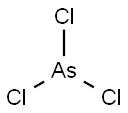삼염화 비소
|
|
삼염화 비소 속성
- 녹는점
- −16 °C(lit.)
- 끓는 점
- 130.2 °C(lit.)
- 밀도
- 2.15 g/mL at 25 °C(lit.)
- 증기 밀도
- 6.25
- 굴절률
- 1.6006 (589.3 nm 20℃)
- 인화점
- 130.2°C
- 용해도
- reacts with H2O; very soluble in chloroform,ctc, ethyl ether
- 물리적 상태
- 액체
- 색상
- 무색~황갈색
- 수용성
- As(OH)3</sub>를 형성하면서 물에서 분해됩니다. 그리고 HCl. 물에서 희석이 증가하면 Assub2O3가 생성됩니다. 강수량
- 감도
- Moisture Sensitive
- Merck
- 14,801
- Dielectric constant
- 12.4(21℃)
- 안정성
- 안정성 물과 반응함. 많은 금속을 부식시킵니다. 칼륨, 나트륨, 알루미늄과 접촉하면 격렬하게 반응함.
- CAS 데이터베이스
- 7784-34-1(CAS DataBase Reference)
안전
- 위험 및 안전 성명
- 위험 및 사전주의 사항 (GHS)
| 위험품 표기 | T,N | ||
|---|---|---|---|
| 위험 카페고리 넘버 | 23/25-50/53 | ||
| 안전지침서 | 20/21-28-45-60-61 | ||
| 유엔번호(UN No.) | UN 1560 6.1/PG 1 | ||
| WGK 독일 | 3 | ||
| RTECS 번호 | CG1750000 | ||
| TSCA | Yes | ||
| 위험 등급 | 6.1 | ||
| 포장분류 | I | ||
| HS 번호 | 28121044 | ||
| 유해 물질 데이터 | 7784-34-1(Hazardous Substances Data) | ||
| 독성 | cyt-hmn:leu 600 nmol/L MUREAV 88,73,81 | ||
| 기존화학 물질 | KE-01943 | ||
| 유해화학물질 필터링 | 97-1-119 | ||
| 중점관리물질 필터링 | 별표2-154 | ||
| 암, 돌연변이성물질 필터링 | 71 | ||
| 함량 및 규제정보 | 물질구분: 유독물질; 혼합물(제품)함량정보: 비소 또는 그 화합물과 비소화합물을 0.1% 이상 함유한 혼합물 |
삼염화 비소 C화학적 특성, 용도, 생산
화학적 성질
colourless oily liquid물리적 성질
Colorless oily liquid; fumes in air; density 2.163 g/ml at 20°C; refractive index 1.621 at 14°C; melts at 0.16°C; boils at 130.2°C; vapor pressure 9.75 torr at 25°C; decomposes in water; soluble in alcohol, ether, HCl and HBr.용도
Arsenic Trichloride is an highly toxic inorganic compounds and is an intermediate in the manufacture of organoarsenic compounds.제조 방법
The compound is generally made from arsenic trioxide by (i) passing chlorine over it or (ii) treating the trioxide with sulfur monochloride, S2Cl2. Alternatively it is prepared from arsenic trioxide by distillation with either concentrated hydrochloric acid or a mixture of sulfuric acid and a metal chloride. Arsenic trichloride may also be prepared by combination of arsenic and chlorine.정의
A poisonous oily liquid. It fumesin moist air due to hydrolysis with watervapor:AsCl3 + 3H2O = As2O3 + 6HCl
Arsenic(III) chloride is covalent and exhibits nonmetallic properties.
일반 설명
A colorless to yellow oily fuming liquid. ARSENIC(III) CHLORIDE is irritating to the skin, eyes, and mucous membranes. Very toxic by inhalation and ingestion.공기와 물의 반응
Fumes in air. Reacts with water to form hydrochloric acid and As(OH)3.반응 프로필
When ARSENIC CHLORIDE is heated to decomposition or on contact with mineral acids, ARSENIC(III) CHLORIDE emits highly toxic fumes of hydrogen chloride and of metallic arsenic. Explodes with Na, K, and Al on impact [Sax, 9th ed., 1996, p. 275]. The interaction of hexafluoroisopropylideneaminolithium with a range of chlorinated and /or fluorinated derivatives of arsenic, boron, phosphorus, silicon, and sulfur yielded a violently exothermic reaction.위험도
Strong irritant to eyes and skin.건강위험
ARSENIC(III) CHLORIDE can cause death. In acute exposures, it is extremely toxic and caustic, owing not only to the poisonous nature of arsenic, but also to the release of hydrochloric acid in the presence of water. Exposure to the skin causes local irritation and blisters. Inhalation or ingestion causes hemorrhagic gastroenteritis resulting in loss of fluids and electrolytes, collapse, shock and death. Chronic poisoning can lead to peripheral nerve damage, skin conditions, liver damage and it has been implicated in the induction of skin and lung cancer. The fatal human dose is 70-180 mg depending on the weight of the victim.화재위험
When in contact with active metals such as arsenic, iron, aluminum, zinc, or when heated to decomposition, ARSENIC(III) CHLORIDE emits highly toxic fumes of arsenic. Upon contact with water hydrogen chloride is produced. Water causes ARSENIC(III) CHLORIDE to decompose to yield arsenic acid and hydrochloric acid. Avoid active metals such as arsenic, iron, aluminum, zinc, decomposed by water to form arsenic hydroxide and hydrogen chloride. Avoid air, ultraviolet light. Hazardous polymerization may not occur.Safety Profile
Confirmed human carcinogen. A poison via inhalation. See also ARSENIC COMPOUNDS and CHLORIDES. Very poisonous; fumes in air. Mutation data reported. When heated to decomposition it emits very toxic fumes of As and Cl-. Highly reactive. Explodes with Na, K, and Al on impact.Synthesis
The direct synthesis of AsCl3 is uneconom ical. An old commercial production method is the Glauber process using arsenic trioxide:As2O3 +6NaCl+3H2SO4?→ 2AsCl3+3Na2SO4+3H2O
However, AsCl3 is easier to produce by react ing As2O3 with gaseous hydrogen chloride at 180–200℃.








